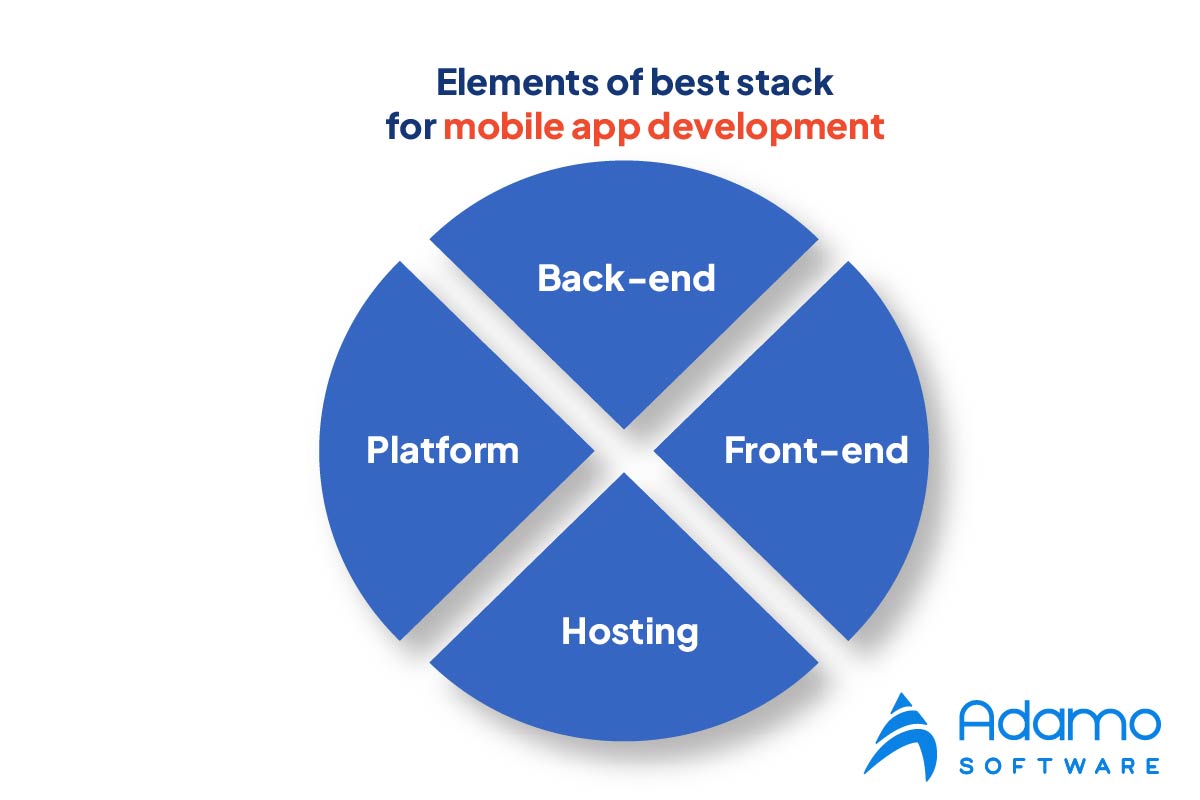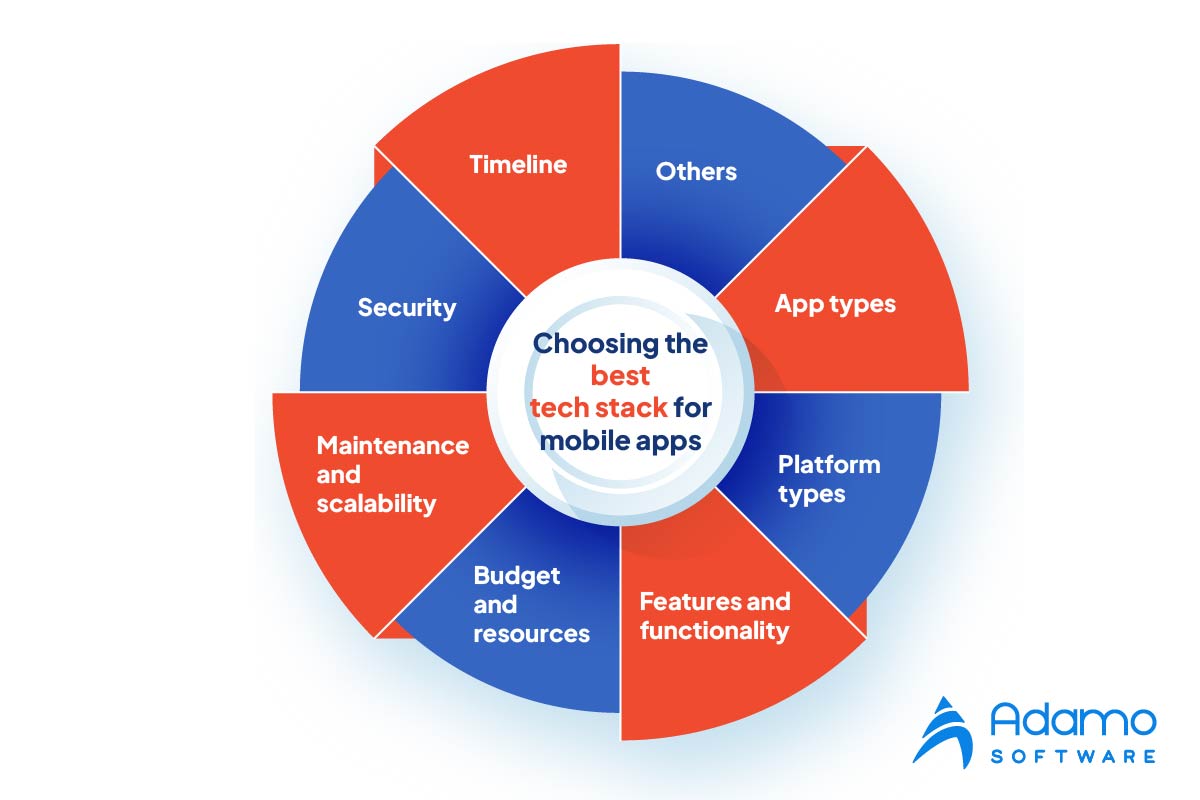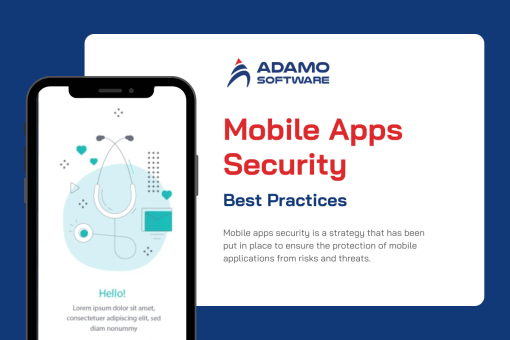Best stack for mobile app development: updated tips for 2026

The app tech stack you select could be the missing link between a creative idea and a successful mobile app.
Currently, the number of mobile users is expanding swiftly. Internet penetration and partial displacement of televisions and computers by telephones, which provide convenient and constant access to information, contribute significantly to the volume of traffic.
According to Statista, there are currently 6 billion smartphone users worldwide, and this figure is expected to increase by several hundred million in the coming years. As a result, it is necessary to utilize new technologies when developing mobile applications. This article observes the best tech stack for mobile app development in 2026, which you should consider when building your app.
1. What is a technology stack?
A tech stack is a collection of technologies used to build an application, including programming languages, frameworks, databases, front-end, and back end tools. Choices regarding your technology stack can have significant repercussions, including the types of integrations you can develop and the skills you’ll need to employ.
Typically, product companies include tools for measuring product and user analytics. Investing in the various components of your tech stack is essential to achieving success as a software company, as your tech stack equips your product team with the tools necessary to create and maintain your product, and to ensure that it continues to meet customer needs.
2. Elements of the best tech stack for mobile app development
We can divide the mobile app development technology infrastructure into four categories:

1. Back end
Software development stores and organizes data and ensures all client-side functionality. Customers may, for instance, log into an account or purchase online. In reality, the back-end handles user requests, database access, and create/read/update/delete operations.
2. Front-end
Development technologies that can assist you in constructing an interface for user interaction. The tech stack incorporates the interface developers’ products, such as icons, animations, the hush function, business logic, and links. Thus, the back-end of a mobile app manages the server-side code and the database.
3. Platform
A mobile platform, such as iOS or Android, provides the operating system and development tools necessary to create and operate an application. This may include iOS SDK or Android SDK technologies and programming languages like Objective-C, Swift, Jave, or Kotlin.
4. Hosting
Hosting guarantees that server-side code executes and provides consumers with the application. This web hosting environment comprises Linus, Apache, and Amazon Web Services (AWS).
III. What to consider when choosing the best tech stack for mobile apps?
Consider the following factors when selecting a tech stack for your mobile app development:

1.App types
The type of app you intend to develop will determine the tech stack you select. A simple app with basic features and functionality, for instance, may not require a complex tech stack, whereas a complex app with advanced features may require a more robust technology stack.
2. Platform types
If you wish to develop an app for a particular platform (iOS, Android, or both), you must choose a tech stack that supports that platform. In general, native app development is optimal for a particular platform, whereas hybrid or cross-platform app development can support multiple platforms.
3. Features and functionality
The features and functionality you wish to include in your application will also impact the tech stack you select. Games, augmented reality, and machine learning, for example, are better suited to certain technology platforms than others.
4. Budget and resources
Your budget and available resources (such as time, expertise, and development team) will also play a role in choosing the appropriate tech stack. Native app development can be more costly and time-consuming, whereas hybrid or cross-platform app development can be more efficient and cost-effective.
5. Maintenance and scalability
Choose a tech stack that will hinder your app’s expansion. Consider technologies that support a stable system architecture as your user base and traffic grow. Your selection of servers, hosting providers, databases, and programming languages can have a significant impact on the expansion and growth of your application.
6. Security
Every mobile app technology must combat defects and associated security flaws. Regardless of the technology you employ, intruders will always search for new entry points. Therefore, your team should understand how to implement security using your selected tech stack.
7. Timeline
In 2020, an average of 113,000 applications were published monthly on Google Play Store. This demonstrates how competitive the industry is, and it is essential to select a tech stack for mobile app development that is compatible with the development schedule.
If you’re developing a minimum viable product, you’ll need tools to have the app available in weeks, not months. However, the full version of the application may be developed using tools that permit the addition of more features, albeit over a lengthier time.
IV. Best tech stack for mobile app development
1. React Native / JavaScript
React Native facilitates JavaScript mobile app development for Android and iOS. Developers who favor React Native tech stack for cross-platform applications cite the following advantages:
_ The number of open-source libraries.
_ Massive community.
_ Reusable UI code.
_ Ideal for mobile MVP applications.
2. Kotlin
Kotlin is a consistent and lightweight tech stack for Android applications. Kotlin is a younger programming language than Java, but it’s already robust. It is also compatible with Java and facilitates development in multiple languages. Kotlin is utilized by many of our internal products and client initiatives.
Android mobile app development is preferable with Kotlin tech stack for the following reasons:
_ Lazy initialization feature for thread prevention.
_ A plain and effective syntax that reduces the number of lines of code by up to 35% compared to Java.
_ Enhanced safety and defect tolerance.
_ Extension function.
_ Large ecosystem, solid assistance, and robust community.
3. Objective-C
Objective-C has been the dominant programming language for years, and it is still widely employed. Objective-C may be an optimal tech stack for mobile app development teams if they need to manage a large legacy project or lack qualified Swift developers.
In addition, you can choose Objective-C tech stack for the following reasons:
_ A tried and tested language
_ Provides excellent compatibility with C++
_ Provides simple access to confidential APIs
_ Has an expressive code syntax
4. Swift
Swift is a relatively new tech stack, but it is among the best for mobile app development. Swift is a more effective and robust technology for iOS app development. Swift development is typically faster and less expensive for businesses. This language is used to develop some of our own products.
It’s quite popular because of the following factors:
_ Increased productivity and performance.
_ Safer and less susceptible to errors.
_ Its plain syntax ensures improved code readability and simplified support.
_ Progressive and versatile language.
_ Significant community support.
5. Python
Python is designed to be a high-level programming language for executing applications on specific devices. This is utilized frequently in the development of websites, software for mobile applications, the automation of device-based duties, and data analysis. Python tech stack is a general-purpose programming language for various applications. It is not used to solve any particular issue.
V. How to choose the best stack for mobile app development
The optimal tech stack for mobile app development is contingent on some factors, including the type of app you wish to develop, the platform you wish to target (iOS, Android, or both), the features and functionality you wish to include, your budget and available resources. Here are some tech stacks for mobile app development. Before exploring the best stack for mobile app development, you can read more about Cloud Service Platforms: What Software Teams Need To Know to get more ideas related to cloud-based service platforms.
1. Native app development
To create a mobile application, native applications use the official software development kits (SDKs) and programming languages for the specific platform (iOS or Android).
Here are the most prevalent development methods:
a. iOS applications
_ Swift is the primary programming language for developing iOS applications. It is an effective, contemporary language that is simple to acquire and employ.
_ Xcode: This is the primary iOS app development environment. It includes a code editor, debugger, and other tools to assist developers in building and testing their applications.
_ The iOS SDK (Software Development Kit) is a compilation of tools and frameworks used to create iOS applications. It comprises frameworks such as UIKit (for constructing user interfaces), Foundation (for managing data), and Core Graphics (for drawing and animation).
_ iOS framework: This framework provides the user interface components and resources required to develop iOS applications. It consists of classes such as icons, labels, tables, and collection views.
_ Databases (such as SQLite or Core Data), networking libraries (such as AFNetworking or Alamofire), and testing frameworks (such as XCTest or Quick) are also frequently used in iOS app development.
b. Android applications
_ Java is the primary programming language for developing Android applications. It is an object-oriented programming language that is simple to learn and use.
_ Android Studio is the principal environment for developing Android applications. It includes a code editor, debugger, and other tools to assist developers in building and testing their applications.
_ The Android SDK (Software Development Kit) is a collection of tools and frameworks for developing Android applications. It incorporates UI (User Interface) elements, data storage, and networking frameworks.
_ Android framework: This is a set of APIs (Application Programming Interfaces) that provide the fundamental functionality for Android applications. It incorporates view management, touch handling, and event handling classes.
_ Kotlin is a modern, statically typed programming language that is compatible with Java and can be used to create Android applications. It is terse, expressive, and simple to learn, and its popularity among Android developers has increased in recent years. Google’s preferred language for Android development is Kotlin, which is completely supported by Android Studio.
2. Hybrid app development
This entails utilizing web technologies such as HTML, CSS, and JavaScript to develop a mobile app that is compatible with multiple platforms. Using tech stacks such as Cordova, PhoneGap, or Ionic, hybrid apps are packaged in a native container and granted access to native device features. The development of hybrid apps is typically less expensive and speedier than the development of native apps but can result in slower performance and a less native-like user experience.
3. Cross-platform app development
This app utilizes a single codebase to create a mobile app that is compatible with multiple platforms. Cross-platform app development tech stacks such as Flutter, React Native, and Xamarin, enable developers to write code in a high-level programming language and then compile it into platform-specific native code.
Cross-platform app development is typically quicker and less expensive than native app development, but it can still result in performance and user experience compromises.
Also read: How to become a mobile app developer? Sooner Know, Achieve Better
VI. Ensure success of your mobile app by selecting Adamo services
Selecting the best stack for mobile app development can be a tough decision since there are lots of essential factors to consider. People can try and select an appropriate solution for tech stacks for mobile app development so many times; however it is essential to have a strategic plan: (1) define software product goals, (2) list out essential features and functionalities and (3) analyze industry.
As the leading software development company in Vietnam, Adamo Software has experience in working with lots of enterprises in many fields, so we can help you choose the best stack for mobile app development for your projects. Explore other mobile app development services at Adamo.











